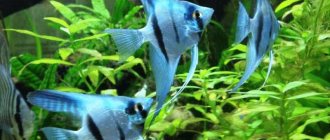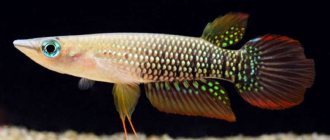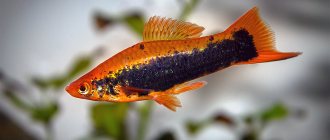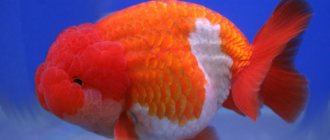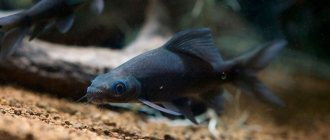Home › Aquarium fish ›
Your rating will be the first!
Pristella (Pristella maxillaris) is a very cute little aquarium fish, tetra, from the characin family. It is also called the “X-ray fish” because its silvery-yellow body is completely transparent. Pristella has remarkably colored fins: the dorsal and anal fins have white tips, followed by a black stripe, followed by a yellow stripe. The tail fin is red or pink. There is also a very popular albino variety, bred through selective breeding: fish of a more muted color with pink eyes and a pink spot. Pristella can also be found under such names as golden pristella, X-ray tetra, water goldfinch, pink-finned tetra.
The popular aquarium fish Pristella is the only species of the genus Pristella, and all commercially available fish are born in captivity. In nature, Tetra pristella lives in the northeastern coastal waters of South America. During the dry season, the fish live in rivers and their tributaries, and during the rainy season, along with rising waters, the pristella moves to the savannah, where it spawns among water-filled vegetation.
Tetra pristella is a wonderful aquarium fish for beginners, extremely hardy and undemanding, tolerates almost any type of water. It occurs naturally in both brackish and soft waters. It can easily withstand hard water, although it prefers to live in soft water. If your home aquarium has dark soil and dim lighting, the X-ray fish will appear to its owners at its best, showing its best colors. But in hard water and in bright light you will not see the full colors of this tetra.
Tetra pristella is suitable for community aquariums with a peaceful community of aquarium fish. She is quite prolific, but the tiny fry are quite difficult to raise. They are very active schooling fish, so they need an aquarium with a volume of 55-75 liters. Not at all dangerous to other fish and plants. It is better to keep them in a group of 6 fish or more; they look especially attractive in a planted aquarium.
Habitat appearance
Pristella belongs to the characin family. It comes from Central and South America, and appeared in European countries in the mid-90s, having managed to win love and popularity among aquarists during this time.
It is distinguished by its tiny, miniature size, since the length of an adult individual is no more than 4-5 cm. At the same time, the body of the pristella seems slightly flattened from the sides. This fish is absolutely transparent, with the exception of its belly, which has a light iridescent silver color.
The picture is complemented by fins - rich yellow-black and scarlet. Extremely rare in nature are the so-called pristellas - albinos, whose colors are dominated by yellow and golden tones. This fish is sometimes called “X-ray”, since it is so transparent that with the naked eye you can clearly see its insides, ridge and even bones, as if in a photograph.
Surprisingly, in this species of fish, the males are more graceful than the females, who have a more rounded and larger abdomen . Pristella is characterized by its excellent adaptive abilities and resistance to most common diseases and the effects of adverse external factors. Leads a predominantly gregarious lifestyle.
Habitat in nature
Pristella was first described in 1894. It lives in South America: it is a widespread fish that lives in the Amazon and Orinoco basins, as well as in the coastal rivers of Guiana. During the dry season, the fish inhabit the clear waters of streams and tributaries, and with the onset of the rainy season, they migrate to flooded areas with dense vegetation.
Unlike most other characins, it is tolerant of (and sometimes lives in) slightly brackish water. Like most other tetras, it feeds primarily on small insects and plankton. They live in flocks, in places with an abundance of plants, where they feed on various insects.
Conditions of detention
Keeping pristella does not create much trouble for aquarists due to its unpretentiousness and good adaptation. The fish is undemanding to water parameters, although it feels best in a soft and slightly acidified environment. In order for the pristella to feel as comfortable as possible and look impressive in the aquarium, you should follow a number of rules:
- Choose a sufficiently large aquarium (designed for at least 50 liters), since this fish prefers to lead a school life, and for full movement and the implementation of its activity it requires a sufficient amount of free space.
- Use soft, diffused and slightly dim lighting. Like other representatives of the characin family, pristella does not respond well to intense, bright lighting.
- Use floating aquatic and emergent plant crops, algae, various driftwood and green spaces as natural shades.
- The ideal soil option would be small pebbles or pre-cleaned river sand.
- The optimal temperature is about +20-28°C;
Pristella needs clean and fresh water, so it is recommended to change the liquid in the aquarium at least once a week. In this case, it will be enough to replace the water by only 20-25% (read more about correct water replacement in an aquarium).
The pristella will feel most comfortable if, when decorating the aquarium, you try to create conditions for it that are as close as possible to its natural habitat.
For these purposes, it is recommended to use a substrate of almond, oak and beech leaves, which also release specific substances - tannins, which activate the immune system of fish. But in this case, the foliage will have to be changed regularly as it grows.
Pristella does not react very well to very hard water; the use of peat, additional filtration and aeration will soften it. It is important that the aquarium has a sufficient amount of vegetation necessary for the fish to play, spawn and relax in solitude.
Description
Star-shaped pristella, or Ridley's pristella (lat. Pristella maxillaris, English X-ray Tetra) is a representative of the characin family, found in the rivers of South and Central America. Its typical habitat is clear, clean streams, tributaries of rivers and standing reservoirs. With the onset of the rainy season, it moves to flooded meadows and forests and spawns on submerged vegetation.
Ridley's pristella appeared in Europe in 1924. In USSR aquariums - a little later, in 1955.
This popular aquarium fish looks very unusual - its tiny (4-4.5 cm) body is flattened on the sides and translucent, with the exception of its silvery belly. For this feature it received its English nickname X-ray Tetra, which can be translated as “tetra X-ray”. Its brightest part is the black and yellow dorsal, anal and ventral fins with white tips. Both lobes of the caudal fin are pale red. Behind the gill covers there is a black, clearly defined spot.
There are also albino forms with a predominant yellowish tint to the body.
Like other characins, pristella prefers the company of its relatives, but at the same time it is reluctant to keep a flock, gathering in a group only in times of danger. In an aquarium, it occupies the water column, supporting the body in space with short bursts.
What to feed
In its natural habitat, pristella feeds primarily on zooplankton. In an aquarium, you can feed your fish both frozen and dry specialized food. An excellent option would be daphnia or artemia. In food, as in care, pristellas are extremely unpretentious, the main thing is that the food is fresh and of good quality.
Experts recommend giving preference to dry food produced in the form of flakes, as they pollute the water to a lesser extent. But live food must also be present in the pristella’s diet. Considering the miniature size of the oral cavity of this subspecies, it is advisable to choose crushed food.
The fish should be fed in small portions, 2-3 times throughout the day.
It is very important to ensure that all the food is absorbed within a few minutes. Otherwise, the water will have to be purified from its residues. Experts advise following 2 important rules - try to diversify the pristella menu as much as possible and in no case overfeed the fish.
Origin of mythical creatures
It’s hard to believe, but all the variety of goldfish has only one ancestor - the silver carp. A common inhabitant of shallow waters in China, Japan, and Korea. Back at 7 a.m. e. people noticed that in its offspring, individuals with orange-red or yellow pigment occasionally appear. They began to catch them and place them in reservoirs near houses. This was the beginning of selective work. The high degree of variability of crucian carp offspring made it possible to select many new interesting specimens with a similar gene pool. Therefore, when different types of goldfish are kept together in an aquarium, they can interbreed and produce offspring. Thus, the purity of the lines is lost.
Best neighbors
Pristella is very peaceful and friendly in nature, so she gets along well with other inhabitants of the aquarium. The best neighbors for her will be fish that are small in size and have a similar temperament:
- panda;
- golden catfish;
- lalius;
- glowing tetra;
- neon;
- ancistrus.
Due to its small size and shyness, it should not be kept in the same reservoir with large, predatory and aggressive fish.
Compatibility
Pristella tetras are very peaceful aquarium fish, ideal for an aquarium with other peaceful fish. It is better to keep them in a flock of six or more individuals - this way they feel more confident and experience less stress. Tetras are very shy and often hide, so it is better to install the aquarium in a quiet, calm place. Other small tetras (neons, amanda tetras, von rio, ternetsia), nannostomus, corydoras, small rasboras, most viviparous fish and loaches are suitable as neighbors.
In slightly brackish water they can be kept with parrot cichlids, spotted etroplus, small gobies and other small non-predatory fish.
Possible problems and diseases
Pristella is considered one of the most hardy, strong and unpretentious varieties of aquarium fish. By nature, she has good immunity and is not susceptible to most diseases typical of other subspecies.
Poor health can only be provoked by a sharp deterioration in living conditions, lack of minimal care, or use of low-quality food. If you follow the basic rules, pristellas feel great and live for at least 4-5 years.
Maintenance and care, arrangement of the aquarium
Unpretentious and hardy, adapts to a wide variety of water conditions. There are no special requirements for design, and it depends only on the imagination and financial capabilities of the aquarist, or on the needs of other neighbors in the aquarium. As for keeping the albino Pristella, it successfully adapts to a fairly wide range of pH and dGH values, however, there are restrictions on the arrangement of the aquarium - it is necessary to provide dim light and use a dark substrate. Maintenance of the aquarium comes down to regular cleaning of the soil from organic waste (uneaten leftover food, excrement) and weekly water changes (15–20% of the volume) with fresh water.
Rules for breeding and reproduction
Under normal conditions, pristella reproduce independently, without outside help. However, if you want to get healthy offspring and engage in professional breeding of these amazing fish, you should take care of “artificial” spawning. To do this, it is necessary to select several pairs: the healthiest, most active and visually attractive individuals of different genders, and temporarily place them in a separate aquarium.
During this period, it is important to regularly change the water and monitor its hardness and acidity levels. It is recommended to feed pristella during breeding with high-calorie, protein foods. This will help you get better quality caviar and milt. As a rule, caviar appears within 2-3 days. If for some reason this does not happen, then the aquarist should replace a pair of pristellas for breeding.
When spawning ends, the parents are moved back to their usual body of water, as they may pose a potential danger to their offspring. The parental instincts of the pristella are not developed, so it can easily feed on eggs and even fry.
The larvae appear after a few days. It is recommended to feed them “live dust”, which can be purchased in specialized stores. As they grow older, microworms, crushed egg yolks, and brine shrimp are added to the fry’s diet.
Only after 2-3 weeks can the fry be placed in an aquarium where other aquatic inhabitants also live.
Pristella is a unique aquarium fish, elegant, miniature, very beautiful and capable of becoming a real decoration in any aquarium. If we take into account its peaceful disposition, omnivorousness and unpretentiousness, then its enormous popularity among aquarists becomes quite understandable. Good quality nutrition, regular cleaning of the aquarium, and adequate water filtration will help prolong the life of the pristella, improve its appearance and improve its health.
Types of labeo with photos
You can find such fish in home ponds.
Labeo bicolor or two-color (Epalzeorhynchos bicolor)
A representative of Thai reservoirs came to Russia in 1959 and quickly attracted the attention of aquarists.
Its contrasting color (velvet black body and bright red tail) leaves no one indifferent. The fins have a translucent appearance.
Green (Epalzeorhynchos frenatus)
It is distinguished by a beautiful olive body color with a golden tint. The abdomen has a clear silvery tint, the fins have a reddish tint.
Albino
Elongated and more graceful, in comparison with other labeos, the body of the albino is colored in a light tone with a pink tint. At the same time, the eyes and fins have a reddish tint.
Black (Morulius chrisophecadion)
Also known as morulis. It is distinguished by beautiful black scales with a brown (less often blue) tint.
Young fish have a gray or silver, rather light color. The black labeo is distinguished from the two-color labeo by its completely black color. The fins are the same shade as the body.
Harlequin
This species of labeo lives in the waters of Africa. It has the property of changing color as it matures.
Thus, juveniles are beige in color, but have brown spots along the body and fins. Adult specimens are gray.
Interesting! The size of this fish can reach 30 cm.
Photo of pristella
Earthworms and lettuce in an aquarium
There is an opinion among aquarists that goldfish eat everything and in unlimited quantities. Their taste preferences are indeed very diverse.
Porridge. Buckwheat, oatmeal, and millet are acceptable. It is not advisable to give in large quantities, it promotes fullness.
Green food. Wolffia can be purchased in frozen briquettes. It is better to breed duckweed. When collected from wild bodies of water, infectious diseases and parasites are often introduced. Spinach and lettuce are given finely chopped. Zucchini, apples, cucumbers, pumpkin, and crushed soybeans are good sources of nutrients.
Ready-made industrial feed. In addition to the special one intended for scrofula, they eat tablets for catfish. In the east, caring for goldfish involves a combination of 3-6 foods at a time. Preference is given to Japanese manufacturers.
Silently exotic. Bananas, kiwi, oranges. In the latter, you need to remove the film from the slice and slightly loosen the pulp and give it to be torn to pieces.
Animal feed. Frozen bloodworms are good because they float on the surface for quite a long time. Earthworms are a free high protein food. First, they are kept in a jar of water for about a day at a temperature of 6-8 degrees. Then they chop it into small pieces with a blade.
It is believed that it is better to feed often, but little by little. After 10 minutes, it is advisable to remove the remains. For convenience, a saucer is placed under the eating area. Catfish are kept as additional orderlies. Pterygoplichts can be recommended for this purpose.
Diseases and methods of their treatment
Labidochromis usually have good health indicators. Diseases can only occur if fish are not properly cared for. The most common cause is food poisoning. In this case, live food that is bought secondhand is considered dangerous. It is often infected with pathogenic bacteria.
In case of poisoning, you can try to save these aquarium fish. To do this, add methylene blue to the water. However, this method only helps in rare cases. Most yellowfish die from toxicosis.
Males can often suffer injuries of varying severity. This happens in fights with rivals when there is a shortage of females. In such cases, the owner of the aquarium must forcefully place the fish. If a pet refuses to eat food and wants to quickly hide, then there is a danger of wound infection. In this case, antibiotics and antifungal drugs are added to the water.
If the water quality is poor, fin rot may occur. In this case, a whitish coating appears on the edges of the fins. If the water is not changed urgently, the infection quickly spreads to the body and the fish dies. If the water quality is satisfactory, then the fish cope with this kind of problems on their own.
Tuberculosis is considered a serious disease of yellow cichlids. It can be caused by bacteria that enter the aquarium with soil and food. Infected individuals begin to quickly lose weight. The eyes bulge greatly. The disease cannot be cured on its own. Therefore, it is important to quickly transplant healthy fish into a clean container, and completely disinfect the infected aquarium.
Thus, Labidochromis are excellent representatives of aquarium fish. Many aquarists love them. This species is often purchased for breeding. If you choose the right aquarium and create the most suitable living conditions for this species, then it is likely that yellow fish will live a long time and reproduce well. To avoid the development of various diseases, you need to carefully monitor the condition of the water in the aquarium, the quality of food and the well-being of your pets.
Nutritional Features
Hummingbird cichlids are essentially predators. But if you define your daily diet as a mixture of plant foods, then no problems should arise. For feeding, purchase special inexpensive food or frozen food. Koretra will be a good treat for yellow fish. For variety, add chopped spinach or lettuce leaves to your diet.
Yellow cichlids should not overeat, so the amount of food should be strictly limited. The daily feed intake is divided into two times. If the fish are overfed, their digestive system begins to suffer, their tummies become swollen and the fish die. It is better to give cichlids dry plant-based food. This also includes minerals, vitamins and keratin, which is of great importance for maintaining the bright color of the scales.


